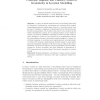72 search results - page 5 / 15 » Structured objects in owl: representation and reasoning |
ILP
2005
Springer
14 years 1 months ago
2005
Springer
Clustering is a fundamental task in Spatial Data Mining where data consists of observations for a site (e.g. areal units) descriptive of one or more (spatial) primary units, possib...
DOCENG
2008
ACM
13 years 9 months ago
2008
ACM
Semantic web researchers tend to assume that XML Schema and OWL-S are the correct means for representing the types, structure, and semantics of XML data used for documents and int...
KI
2010
Springer
13 years 6 months ago
2010
Springer
Location models are data structures or knowledge bases used in Ubiquitous Computing for representing and reasoning about spatial relationships between so-called smart objects, i.e....
LREC
2008
13 years 9 months ago
2008
OntoSelect is a dynamic web-based ontology library that harvests, analyzes and organizes ontologies published on the Semantic Web. OntoSelect allows searching as well as browsing ...
Book
"Spatial structures and spatial reasoning are essential to perception and cognition. Much
day-to-day practical information is about what happens at certain spatial locations....

